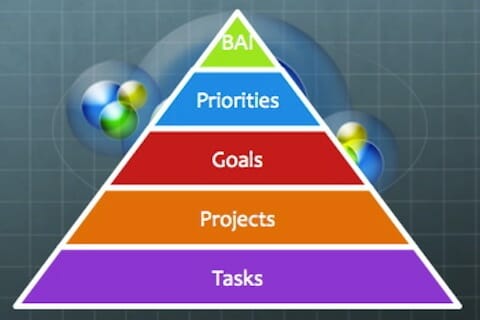If you like this post be sure to check out follow-up The Cycle of Getting the Important Stuff Done for even more.
There is always more that you want to do than you can humanly or otherwise actually do. That’s just the nature of owning a business and the minute you let up it comes right back at you.
The key is to find a way to focus on the right things and let the other things, no matter how loud and shiny, go.
The trouble is that in the course of a week, a day or even an hour, what’s important work and what’s a distraction can look pretty much the same unless you have a plan – A plan for knowing what’s important, a plan for what’s now and a plan for what’s next.
While this may sound like a to do list, and perhaps there is an element of that, it’s much more than that. It’s actually a strategy that begins with it a clear understanding about what’s pulling you forward, what’s on the horizon, what’s your target, what’s the next hill and what’s on tap for the day.

There is a hierarchy of work that must ebb and flow throughout your days and weeks that acts as the filter for your focus. This hierarchy has to inform what you allow yourself to do and not do throughout your week.
You can only focus on so many things and if you are to move your business forward in a way that doesn’t feel like treading water you’ve got to focus on the right things.
BAI – At the top of the pyramid is what I call your one big audacious idea. This is the one thing that is far out there, but that possesses a gravitational pull that keeps you going. It’s the big thing you know you want your business to become, even if you’re not really sure today how you’ll get there.
I believe you must always take stock of this idea and make sure it’s alive and, in some cases, actually big enough to alter your behavior. Without this pull, the other stages can turn into busy work.
Priorities – Each year you should define your top 3-4 priorities. Keep this list small or your focus will become diluted. Most business can’t accomplish more than this number and trying to do so means nothing really get accomplished. This is also a great way to identify the highest payoff work when it comes down to utilizing scarce resources like the owner’s time.
When you pare your list to only the top priorities, you have a filter for making determinations about what projects or great new ideas should actually receive consideration going forward. If they don’t support one of you annual priorities, they go on the back burner for later consideration. It’s a great way to keep everyone moving in the same direction, including the self-sabotaging owner!
Goals – Everyone is familiar with the idea of using goals, but few businesses establish goals as a key way to track and measure progress, particularly as it relates to the stated major priorities for the year.
After you agree upon the 3-4 priority objectives, you must establish goals that allow you to track your progress in ways that help you understand what’s working and what’s not.
Projects – Each of you priorities will involve any number of projects. For example, if one of your primary objectives for the year is to increase revenue by X percent, you’ll probably need to identify a series of projects that are geared towards reaching that objective. This might include a new product launch or aggressive lead generation campaign.
You should attempt to identify only a handful of ongoing projects that support your main objectives on a quarter by quarter basis. These projects should have owners and supporters and progress should be tracked and reported on a weekly basis.
Tasks – The smallest unit of work is the task. Even so, tasks should be associated with projects, which in turn support the primary objectives.
Now, tasks often pop up in the form of the daily to do list. Where people fail in their the day to day productivity is that many don’t use to do lists and those that do employ them don’t always have the end in mind when they plan.
The hierarchy of important stuff suggests that unless you plan with the end in mind, or with a focus on the big audacious idea, you’ll constantly fall victim to the swirl of what seems important at the time.
When you build your pyramid from the top down you can plan your days, weeks and months with each of stages firmly rooted in every decision you make hour by precious hour.

